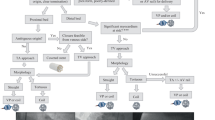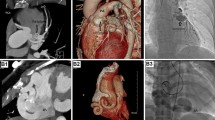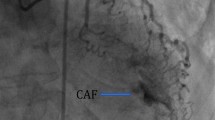Abstract
Purpose
The study sought to determine coronary artery diameter in congenital coronary-cameral fistula (cCCF), factors associated with coronary artery aneurysm, coronary artery changes after fistula closure, and computed tomographic (CT) findings after treatment.
Materials and methods
We retrospectively reviewed CT findings of the cCCF for origins, terminations, fistula length, complexities, and Sakakibara classification. Coronary artery diameter was expressed as coronary artery Z score. Fistula features associated with coronary artery aneurysm were analyzed. Post-fistula closures were analyzed for coronary artery dilatation, coronary thrombosis, complete fistula closure, and fistula thrombosis.
Results
Twenty-five patients (median age 33 months, interquartile range, IQR 25–48) were included. Coronary feeders and terminations were frequently right coronary artery (48%) and right ventricle (56%), respectively. Fistula aneurysm occurred in 52% of cases. Mean coronary artery Z score was 13.03 ± 6.36 with a high incidence of giant coronary artery aneurysm (68%). We found no statistically significant risk factors associated with coronary artery aneurysm (p value range 0.075–0.370). Median duration of the follow-up CT after closure of the fistulas was 6.4 months (IQR 5.0–8.7). Coronary artery Z score significantly decreased by 0.82 (IQR 0.28–1.35), p = 0.006 and coronary thrombosis occurred in 23% of cases during follow-up.
Conclusions
Large coronary aneurysm is common in cCCF. No characteristic feature of the fistula influencing coronary artery aneurysm is identified. There is a diminution in coronary artery Z score after fistula closure. Coronary thrombosis is a major complication after treatment.





Similar content being viewed by others
Change history
24 July 2023
A Correction to this paper has been published: https://doi.org/10.1007/s11604-023-01472-5
Abbreviations
- cCCF:
-
Congenital coronary-cameral fistula
- CTCA:
-
Computed tomographic coronary angiography
- DLP:
-
Dose-length product
- LAD:
-
Left anterior descending artery
- LCx:
-
Left circumflex artery
- LMCA:
-
Left main coronary artery
- RCA:
-
Right coronary artery
- TCC:
-
Transcatheter closure
References
Yun G, Nam TH, Chun EJ. Coronary artery fistulas: pathophysiology, imaging findings, and management. Radiographics. 2018;38:688–703.
Ogden JA. Congenital anomalies of the coronary arteries. Am J Cardiol. 1970;25:474–9.
Latson LA. Coronary artery fistulas: how to manage them. Catheter Cardiovasc Interv. 2007;70:110–6.
Shiga Y, Tsuchiya Y, Yahiro E, Kodama S, Kotaki Y, Shimoji E, et al. Left main coronary trunk connecting into right atrium with an aneurysmal coronary artery fistula. Int J Cardiol. 2008;123:e28-30.
Shah AH, Leventhal A, Osten M, Benson L, Horlick E. Coronary artery fistulae: indications for treatment and technical considerations. J Struct Heart Dsc. 2016;2:47–57.
Challoumas D, Pericleous A, Dimitrakaki IA, Danelatos C, Dimitrakakis G. Coronary arteriovenous fistulae: a review. Int J Angiol. 2014;23(1):1–10.
Sharma A, Pandey NN, Kumar S. Imaging of coronary artery fistulas by multidetector CT angiography using third generation dual source CT scanner. Clin Imaging. 2019;53:89–96.
Haycock GB, Schwartz GJ, Wisotsky DH. Geometric method for measuring body surface area: a height-weight formula validated in infants, children, and adults. J Pediatr. 1978;93:62–6.
Trattner S, Chelliah A, Prinsen P, Ruzal-Shapiro CB, Xu Y, Jambawalikar S, et al. Estimating effective dose of radiation from pediatric cardiac CT angiography using a 64-MDCT scanner: new conversion factors relating dose-length product to effective dose. AJR Am J Roentgenol. 2017;208:585–94.
Qureshi SA. Coronary arterial fistulas. Orphanet J Rare Dis. 2006;1:51.
Díaz-Zamudio M, Bacilio-Pérez U, Herrera-Zarza MC, Meave-González A, Alexanderson-Rosas E, Zambrana-Balta GF, et al. Coronary artery aneurysms and ectasia: role of coronary CT angiography. Radiographics. 2009;29:1939–54.
Sakakibara S, Yokoyama M, Takao A, Nogi M, Gomi H. Coronary arteriovenous fistula nine operated cases. Am Heart J. 1966;72:307–14.
Kobayashi T, Fuse S, Sakamoto N, Mikami M, Ogawa S, Hamaoka K, et al. A new Z score curve of the coronary arterial internal diameter using the Lambda-Mu-Sigma method in a pediatric population. J Am Soc Echocardiogr. 2016;29:794-801.e29.
McCrindle BW, Rowley AH, Newburger JW, Burns JC, Bolger AF, Gewitz M, et al. Diagnosis, treatment, and long-term management of kawasaki disease: a scientific statement for health professionals from the american heart association. Circulation. 2017;135:e927–99.
Yamanaka O, Hobbs RE. Coronary artery anomalies in 126,595 patients undergoing coronary arteriography. Cathet Cardiovasc Diagn. 1990;2:28–40.
Vavuranakis M, Bush CA, Boudoulas H. Coronary artery fistulas in adults: incidence, angiographic characteristics, natural history. Cathet Cardiovasc Diagn. 1995;35:116–20.
Sapin P, Frantz E, Jain A, Nichols TC, Dehmer GJ. Coronary artery fistula: an abnormality affecting all age groups. Medicine (Baltimore). 1990;69:101–13.
Reddy K, Gupta M, Hamby RI. Multiple coronary arteriosystemic fistulas. Am J Cardiol. 1974;33:304–6.
Said SAM, Lam J, van der Werf T. Solitary coronary artery fistulas: a congenital anomaly in children and adults. A contemporary review. Congenit Heart Dis. 2006;1(3):63–76.
Fernandes ED, Kadivar H, Hallman GL, Reul GJ, Ott DA, Cooley DA. Congenital malformations of the coronary arteries: the Texas Heart Institute experience. Ann Thorac Surg. 1992;54:732–40.
Levin DC, Fellows KE, Abrams HL. Hemodynamically significant primary anomalies of the coronary arteries. Angiogr Asp Circ. 1978;58:25–34.
Lin FC, Chang HJ, Chern MS, Wen MS, Yeh SJ, Wu D. Multiplane transesophageal echocardiography in the diagnosis of congenital coronary artery fistula. Am Heart J. 1995;130:1236–44.
Roberts WC. Major anomalies of coronary arterial origin seen in adulthood. Am Heart J. 1986;111:941–63.
Reddy G, Davies JE, Holmes DR, Schaff HV, Singh SP, Alli OO. Coronary artery fistulae. Circ Cardiovasc Interv. 2015. https://doi.org/10.1161/CIRCINTERVENTIONS.115.003062.
Gowda ST, Forbes TJ, Singh H, Kovach JA, Prieto L, Latson LA, et al. Remodeling and thrombosis following closure of coronary artery fistula with review of management: large distal coronary artery fistula–to close or not to close? Catheter Cardiovasc Interv. 2013;82:132–42.
Lo MH, Lin IC, Hsieh KS, Huang CF, Chien SJ, Kuo HC, et al. Mid- to long-term follow-up of pediatric patients with coronary artery fistula. J Formos Med Assoc. 2016;115:571–6.
Jaffe RB, Glancy DL, Epstein SE, Brown BG, Morrow AG. Coronary arterial-right heart fistulae long-term observations in seven patients. Circulation. 1973;47:133–43.
Gowda ST, Latson LA, Kutty S, Prieto LR. Intermediate to long-term outcome following congenital coronary artery fistulae closure with focus on thrombus formation. Am J Cardiol. 2011;107:302–8.
Urrutia-S CO, Falaschi G, Ott DA, Cooley DA. Surgical management of 56 patients with congenital coronary fistulas. Ann Thrac Surg. 1983;35:300–7.
Chandra N, Sarkar A, Pande A. Large congenital coronary arteriovenous fistula between the left main coronary artery and right superior vena cava, associated with aneurysmal dilatation of the left main coronary artery: rare case report. Cardiol Young. 2015;25:143–5.
Inoue H, Ueno M, Yamamoto H, Matsumoto K, Tao K, Sakata R. Surgical treatment of coronary artery aneurysm with coronary artery fistula. Ann Thorac Cardiovasc Surg. 2009;15:198–202.
Valente AM, Lock JE, Gauvreau K, Rodriguez-Huertas E, Joyce C, Armsby L, et al. Predictors of long-term adverse outcomes in patients with congenital coronary artery fistulae. Circ Cardiovasc Interv. 2010;3:134–9.
Yamasaki Y, Kawanami S, Kamitani T, Sagiyama K, Shin S, Hino T, et al. Free-breathing 320-row computed tomographic angiography with low-tube voltage and hybrid iterative reconstruction in infants with complex congenital heart disease. Clin Imaging. 2018;50:147–56.
Yamasaki Y, Kamitani T, Sagiyama K, Matsuura Y, Hida T, Nagata H. Model-based iterative reconstruction for 320-detector row CT angiography reduces radiation exposure in infants with complex congenital heart disease. Diagn Interv Radiol. 2021;27:42–9.
Funding
The authors declared that they have not received any grants or other funding.
Author information
Authors and Affiliations
Corresponding author
Ethics declarations
Conflicts of interest
The authors of this manuscript have no conflicts of interest.
Ethical approval
The study was approved by the institutional Human Research Ethics Committee, Faculty of Medicine, Ramathibodi Hospital, Mahidol University. All procedures performed in this studies were in accordance with the ethical standards of the institutional and national research committee and with the 1964 Helsinki Declaration and its later amendments or comparable ethical standards.
Additional information
Publisher's Note
Springer Nature remains neutral with regard to jurisdictional claims in published maps and institutional affiliations.
About this article
Cite this article
Siripornpitak, S., Sriprachyakul, A., Promphan, W. et al. Coronary artery changes in congenital coronary-cameral fistulas evaluated by computed tomographic angiography. Jpn J Radiol 39, 1149–1158 (2021). https://doi.org/10.1007/s11604-021-01164-y
Received:
Accepted:
Published:
Issue Date:
DOI: https://doi.org/10.1007/s11604-021-01164-y




